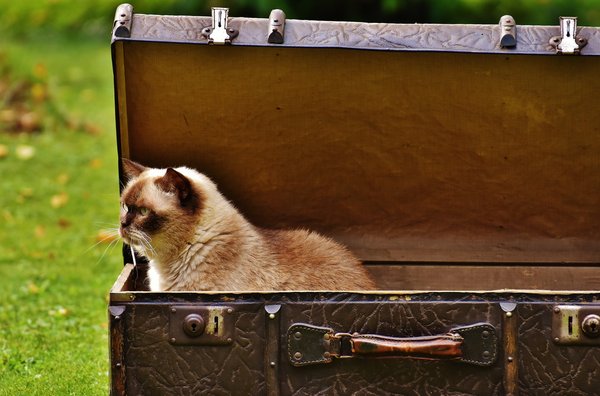First of all, it is important to note that Schrödinger’s cat originated in the discussion of quantum mechanics. And when it comes to quantum physics, it’s always good to remember Richard Feynman’s phrase: “If you think you understand quantum physics, it’s because you don’t.”
Many people sum up the story of Schrödinger’s cat apart from the animal’s ability to be both alive and dead at the same time, depending on the observer (of course there has never been any cat alive and dead at the same time, contrary to what some people believe). All this was a mental exercise suggested by the physicist Erwin Schrödinger in his letters to Einstein.
However, as much as this animal was only present in Erwin Schrödinger’s head, its impact on the world is very real. In this text, we seek to explain in greater depth how and how far this idea emerged.

Schrödinger: A scientist, but also a Joker
Erwin Schrödinger was a great Austrian physicist, winner of the 1933 Nobel Prize in Physics, and is considered the “father of quantum mechanics.” At the time, researchers were still trying to explain the strange behaviors of subatomic particles. Then the Danish Niels Bohr proposed his interpretation of Copenhagen.
Very briefly, this interpretation says that subatomic particles do not have definite states until they are measured: they are in a “superposition of states” and can be in one state or another, when observed, 50% of each. Einstein did not like this theory, and Schrödinger found it absurd. So he wrote the story about the cat to show how absurd this interpretation was for him.
Schrödinger could have written screenplays or done anything, but the guy made up a short story with a cat. In addition to being a genius, he was creative!
The real story of the cat
Just like children’s stories, which are passed down from generation to generation and many people have never made contact with the original, it happened with Schrödinger’s cat. The idea is part of the article The current state of quantum mechanics, published in 1935, says, “Anyone can make very silly cases.” If she is.
In the original description, Schrödinger suggests locking the cat into a steel chamber, along with a vial of poison, a hammer, a Geiger counter (which measures radiation) and a small amount of radioactive material. The box is closed for one hour, during which time the substance may or may not emit radiation, triggering the counter, causing the hammer to be released and the poison bottle to break, killing the cat.
According to the Copenhagen interpretation, the atoms of the radioactive substance remain in a state of superposition until someone notices them. If the atom is in two states – resurrect NS Does not emit radiation – then the system NS She was not stimulated, and the cat was left alive NS Died at the same time. The thing is silly, because cats can only be alive where dead, right?
exactly! This was Schrödinger’s way of showing that he did not believe in the Copenhagen interpretation. “This prevents us from naively accepting an ‘inaccurate model’ of representing reality,” he wrote.
The cat is alive and dead! (Photo: Wikimedia Commons)
The cat is alive!
So, does this mean that after this polemical beating, the whole world bowed to the genius of Erwin Schrödinger and got rid of the Copenhagen interpretation? not exactly. As said, quantum mechanics (or physics) is a topic that confuses even those in the field, so imagine a human being, like this editor here…
Schrödinger wanted to prove that the Copenhagen interpretation was absurd, but it was still a widely accepted theory to explain subatomic phenomena. However, the cat story showed some inconsistencies in the theory (which are still debated today) and raised the hypothesis that there is some boundary between the “quantum world” and the “real world”.
Scientists do not yet know what this limit is or what prevents superposition of states from being observed in larger objects (such as a cat). The day they find out, things and even humans can enter a quantum state of being in two places at once or alive and dead simultaneously. Science has gone so far as to do this with a few thousand atoms, but not with larger bodies made up of different types of atoms (like a cat).
Moreover, it was from his writings on the ‘undead’ cat and the discussions that followed that Schrödinger helped create the concept of quantum entanglement. In short, particles that necessarily have an analogue are in the opposite case: if one is alive, the other is dead, and the two are always connected, for example. These ideas are very important in the field of quantum computing. The issue of monitoring, which was proposed in Schrödinger’s Cat problem, aided the development of fiber-optic technologies.
The debate continues in Science. The cat is alive more than ever!

The cat is also a culture
Finally, it is interesting to note that Schrödinger’s cat, unlike other ideas in quantum physics, ended up entering popular culture. Since the 1930s, science fiction works have appeared with this cat as a character, as well as references in several other characters (Dirk Jalili Comprehensive Detective Agency, Douglas Adams, for example).
The problem – or its anecdotal abbreviated versions – served the texts of many series, from The Big Bang Theorypasser by Futurama, Phineas and Ferb, Rick and Morty, until the last success darkfrom Netflix. There are also many examples in games, such as outlet NS ghost trick.
Quantum mechanics theories have also inspired a lot of trainers who talk about “positive thinking” and put some references to “physics” in the middle of the text to try and put a bit of science into the “blah blah blah” people ignore.
And whether this text about Schrödinger’s cat is good or not is also up to the observer. I hope, from the readers’ point of view, all is well, and after that, my Mega Curioso career remains alive!

“Wannabe internet buff. Future teen idol. Hardcore zombie guru. Gamer. Avid creator. Entrepreneur. Bacon ninja.”

